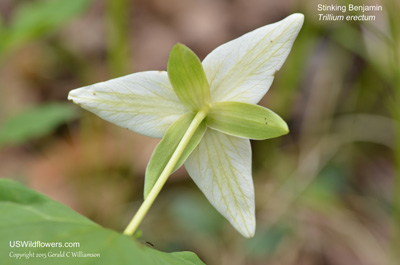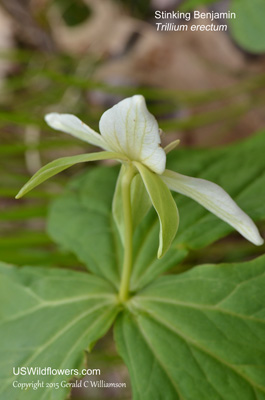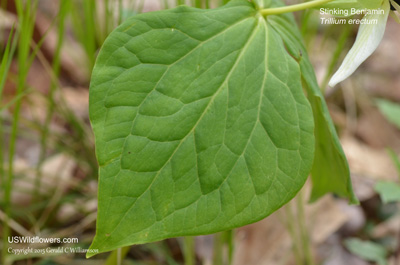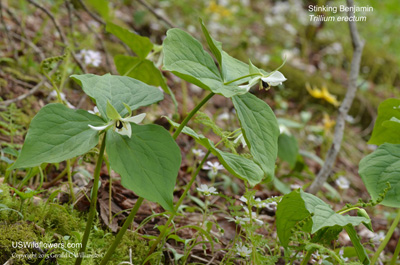Wildflowers of the United States | |||||||||||||
| |||||||||||||
Trillium erectum - Red Trillium, Stinking Benjamin, Red Wakerobin, Wet Dog Trillium, Purple Wakerobin. There are three similar Trillium species with the dark, nearly black ovaries - Trillium simile, Trillium erectum, and Trillium sulcatum. To further confuse, all may have red (maroon) or white petals (T. erectum may have yellowish or greenish petals as well.) White petals are the norm for T. simile, are uncommon but not real rare in T. erectum, and may occasionally occur in T. sulcatum. T. sulcatum flowers are smaller than the flowers of the other two species, and in T. sulcatum the petals are only slightly longer than the sepals.
| It is more difficult to tell the difference between T. simile and T. erectum. The sepals and petals of T. erectum will usually be "flatter" - closer to being in the same plane with each other - than those of T. simile. The petals of T. simile are wider relative to the sepals, usually twice as wide or more, and are more likely to be recurved near the tip than those of T. erectum. With those difficult differentiators, perhaps the easiest way to tell the difference between these two species is to remember these common names and use them in reference to the fragrance - T. simile is "Sweet White Trillium", with a sweet fragrance similar to green apples, and T. erectum is "Stinking Benjamin", with an unpleasant musty odor more like that of a wet dog. As mentioned above, the petals of T. erectum - the species presented here - are more commonly red than white, green, or yellowish, so another of the several common names for this plant is Red Trillium. There is some dispute as to whether the plants with the white petals, as shown here, are deserving of varietal classification (T. erectum var. album) or should instead be classified as a form; Flora of North America still lists it as a variety while stating that it more likely should be a form, and ITIS does not accept the varietal classification, so it appears that what is presented on this page is the white form of Trillium erectum. Trillium erectum is mostly a northeastern species, it does extend its reach in the Appalachian Mountains southward to northern Alabama and Georgia. While it is reported that in the Smoky Mountains the white form is more common in the lower elevations and the red form in the upper elevations, the white form presented here were photographed at an elevation of nearly 5,000 feet. Found in: AL, CT, DE, GA, IL, IN, KY, MA, MD, ME, MI, NC, NH, NJ, NY, OH, PA, RI, SC, TN, VA, VT, WV Leave comments on Trillium erectum at this link.   Blue=Native; Grey=Introduced Map from USDA Plants Database: USDA, NRCS. 2017. The PLANTS Database (http://plants.usda.gov, 03 Apr 2025). National Plant Data Team, Greensboro, NC 27401-4901 USA. Search Our Database: Enter any portion of the Scientific, Common Name, or both. Do a general Google search of the entire site: #ad #ad
| #ad
| | ||||||||||
|
Commercial / Cookie Notice Looking for Wildflowers for a specific state? Check here: | |||||||||||||
|
| |||||||||||||





